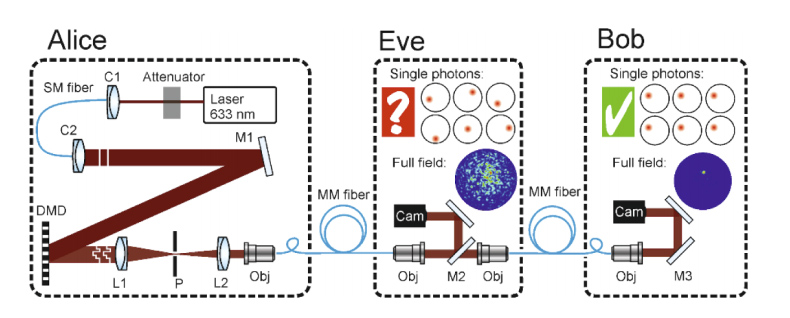Securing our vulnerable computer systems constantly demands alertness. But what about the physical connections, the glass fibers connecting the computers? Could hackers the intercept the light from the fiber, and simply get confidential data, or take over the connection? Not if the new method, designed by University of Twente researchers, is used. They designed a security method for ‘multimode’ glass fibers. It is based on the quantum nature of light, in which one single photon can represent a whole alphabet. The results are in the ‘Optics Express’ journal of The Optical Society.
Most of the glass fiber connections, especially the long distance ones, are ‘single-mode’: they have one way in which light propagates through the fiber. Would you look into the fiber, then you would notice that the light is either ‘on’ or ‘off’. They can, however, transport many colors of light, representing many channels and huge amounts of data through a single fiber. ‘Multi-mode’ fibers have a larger diameter and they transport various wave forms, for even higher data rates. Until now, they are used at short distances, in data centers for example. But they will be a good candidate for connecting the base stations of the new 5G standard, for example. It is already possible to protect single mode fibers using the quantum properties of light. The UT researchers led by Professor Pepijn Pinkse now found a new way of securing data transport through multimode fibers. Looking at the fiber’s cross section on the receiver’s side, the light arrives at a predestined location. Apart from that, the method uses the property of a photon that it can contain more information than one bit.
Programming light
If you would look inside a multimode fiber, you would see a pattern of speckles of various intensities, caused by the different wave forms: the light is already scrambled. The UT researchers add a new operation to this, called ‘wave front shaping’. The receiver can define a number of locations of light on the glass fiber at which the data has to reach him or her. The sender will program the light in such a way that it arrives exactly at the right spot. So, by shaping the light at the sender’s side, the receiver gets the desired pattern.

Bob receives the signal at a predestined spot, determined by the programming ('wave front shaping') on Alice's side. Intercepting by Eve results in a speckled pattern that says nothing about the data.
In this way, one photon at the right location is enough. As soon as the sender and the receiver agree, the data will be sent in this unique way. Using a mirror and a camera to pick up the light, somewhere along the fiber, doesn’t make sense: a hacker can do nothing with the patterns of photons at that location. Even if he is early and tries to intercept the agreement process, says Pinkse: “The negotiation phase between sender and receiver, may seem vulnerable. But for an interceptor, it remains unclear how the light will be programmed.” Sending a signal of his own to the receiver, will not help either: it will not be recognized.
It is a new multidimensional version of the well known Quantum Key Distribution that is used in single mode fibers, for example. ‘Wave front shaping’ is a technology that was developed in Twente, for sending programmed light through a scattering medium like paint. This could lead to a credit card that is fraud-proof. The strong scattering of light in paint resembles the scrambling of light in a multimode fiber. The researchers used the high level of unpredictability of scattering in their new method. Even in case of the doomsday scenario, in which quantum computers will be able to crack most of today’s security measures, this new approach will not be affected.
The research was done in the Complex Photonics Group, part of UT’s MESA+ Institute. The paper ‘Quantum key establishment via a multimode fiber’, by Lyubov Amitonova, Tristan Tentrup, Ivo Vellekoop and Pepijn Pinkse, is published in Optics Express.





